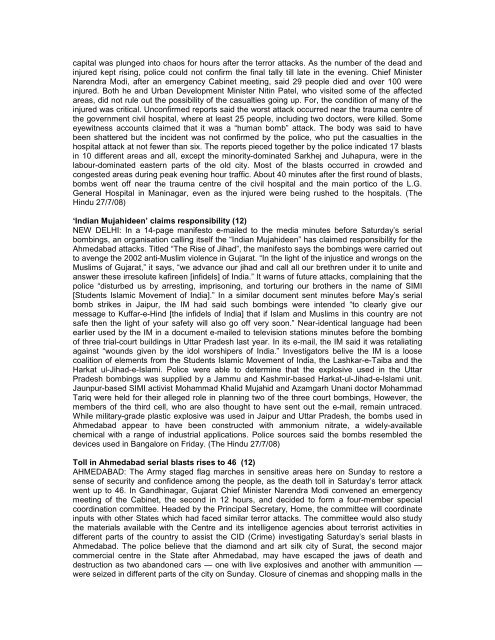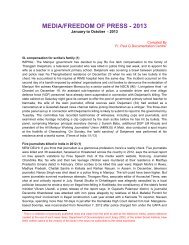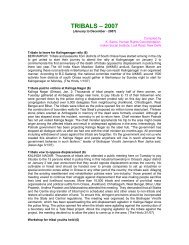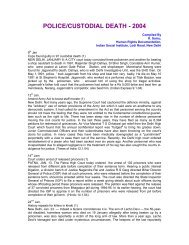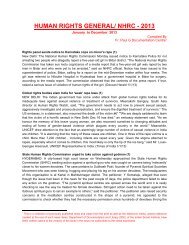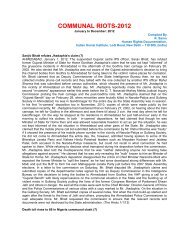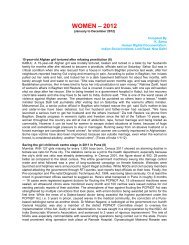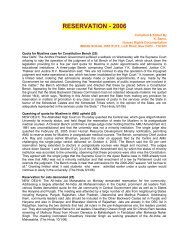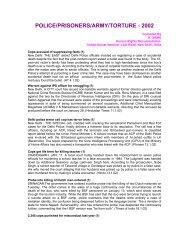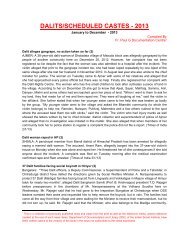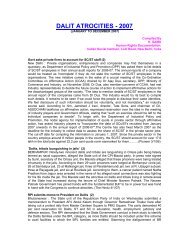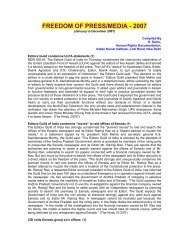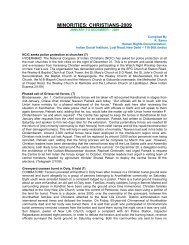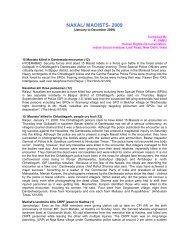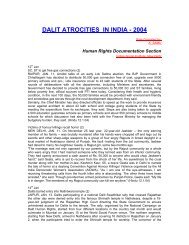TERRORISM - 2008 - Indian Social Institute
TERRORISM - 2008 - Indian Social Institute
TERRORISM - 2008 - Indian Social Institute
Create successful ePaper yourself
Turn your PDF publications into a flip-book with our unique Google optimized e-Paper software.
capital was plunged into chaos for hours after the terror attacks. As the number of the dead and<br />
injured kept rising, police could not confirm the final tally till late in the evening. Chief Minister<br />
Narendra Modi, after an emergency Cabinet meeting, said 29 people died and over 100 were<br />
injured. Both he and Urban Development Minister Nitin Patel, who visited some of the affected<br />
areas, did not rule out the possibility of the casualties going up. For, the condition of many of the<br />
injured was critical. Unconfirmed reports said the worst attack occurred near the trauma centre of<br />
the government civil hospital, where at least 25 people, including two doctors, were killed. Some<br />
eyewitness accounts claimed that it was a “human bomb” attack. The body was said to have<br />
been shattered but the incident was not confirmed by the police, who put the casualties in the<br />
hospital attack at not fewer than six. The reports pieced together by the police indicated 17 blasts<br />
in 10 different areas and all, except the minority-dominated Sarkhej and Juhapura, were in the<br />
labour-dominated eastern parts of the old city. Most of the blasts occurred in crowded and<br />
congested areas during peak evening hour traffic. About 40 minutes after the first round of blasts,<br />
bombs went off near the trauma centre of the civil hospital and the main portico of the L.G.<br />
General Hospital in Maninagar, even as the injured were being rushed to the hospitals. (The<br />
Hindu 27/7/08)<br />
‘<strong>Indian</strong> Mujahideen’ claims responsibility (12)<br />
NEW DELHI: In a 14-page manifesto e-mailed to the media minutes before Saturday’s serial<br />
bombings, an organisation calling itself the “<strong>Indian</strong> Mujahideen” has claimed responsibility for the<br />
Ahmedabad attacks. Titled “The Rise of Jihad”, the manifesto says the bombings were carried out<br />
to avenge the 2002 anti-Muslim violence in Gujarat. “In the light of the injustice and wrongs on the<br />
Muslims of Gujarat,” it says, “we advance our jihad and call all our brethren under it to unite and<br />
answer these irresolute kafireen [infidels] of India.” It warns of future attacks, complaining that the<br />
police “disturbed us by arresting, imprisoning, and torturing our brothers in the name of SIMI<br />
[Students Islamic Movement of India].” In a similar document sent minutes before May’s serial<br />
bomb strikes in Jaipur, the IM had said such bombings were intended “to clearly give our<br />
message to Kuffar-e-Hind [the infidels of India] that if Islam and Muslims in this country are not<br />
safe then the light of your safety will also go off very soon.” Near-identical language had been<br />
earlier used by the IM in a document e-mailed to television stations minutes before the bombing<br />
of three trial-court buildings in Uttar Pradesh last year. In its e-mail, the IM said it was retaliating<br />
against “wounds given by the idol worshipers of India.” Investigators belive the IM is a loose<br />
coalition of elements from the Students Islamic Movement of India, the Lashkar-e-Taiba and the<br />
Harkat ul-Jihad-e-Islami. Police were able to determine that the explosive used in the Uttar<br />
Pradesh bombings was supplied by a Jammu and Kashmir-based Harkat-ul-Jihad-e-Islami unit.<br />
Jaunpur-based SIMI activist Mohammad Khalid Mujahid and Azamgarh Unani doctor Mohammad<br />
Tariq were held for their alleged role in planning two of the three court bombings, However, the<br />
members of the third cell, who are also thought to have sent out the e-mail, remain untraced.<br />
While military-grade plastic explosive was used in Jaipur and Uttar Pradesh, the bombs used in<br />
Ahmedabad appear to have been constructed with ammonium nitrate, a widely-available<br />
chemical with a range of industrial applications. Police sources said the bombs resembled the<br />
devices used in Bangalore on Friday. (The Hindu 27/7/08)<br />
Toll in Ahmedabad serial blasts rises to 46 (12)<br />
AHMEDABAD: The Army staged flag marches in sensitive areas here on Sunday to restore a<br />
sense of security and confidence among the people, as the death toll in Saturday’s terror attack<br />
went up to 46. In Gandhinagar, Gujarat Chief Minister Narendra Modi convened an emergency<br />
meeting of the Cabinet, the second in 12 hours, and decided to form a four-member special<br />
coordination committee. Headed by the Principal Secretary, Home, the committee will coordinate<br />
inputs with other States which had faced similar terror attacks. The committee would also study<br />
the materials available with the Centre and its intelligence agencies about terrorist activities in<br />
different parts of the country to assist the CID (Crime) investigating Saturday’s serial blasts in<br />
Ahmedabad. The police believe that the diamond and art silk city of Surat, the second major<br />
commercial centre in the State after Ahmedabad, may have escaped the jaws of death and<br />
destruction as two abandoned cars — one with live explosives and another with ammunition —<br />
were seized in different parts of the city on Sunday. Closure of cinemas and shopping malls in the


